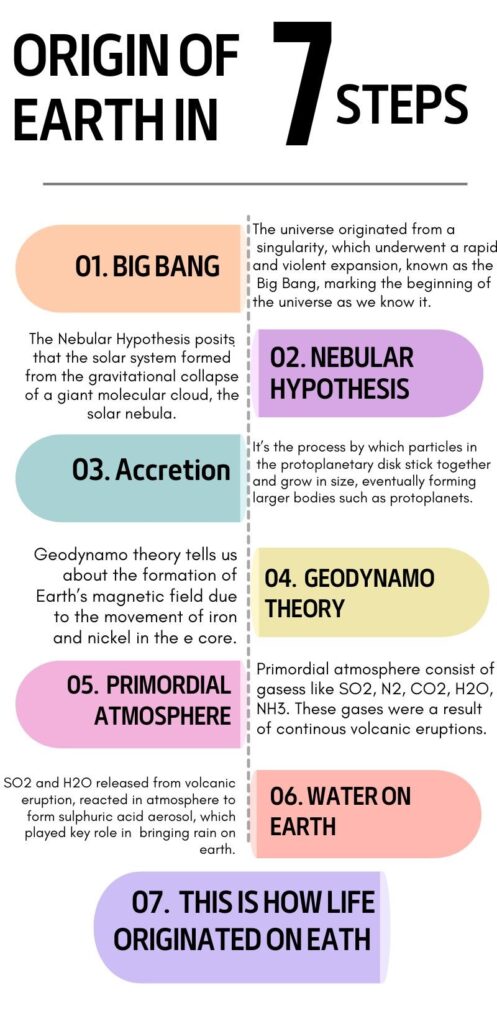Have you ever wondered why Earth supports life while other planets do not? Imagine a time when Earth was a molten sphere with no continents or oceans—how did it evolve into the blue planet we know?
These thrilling questions has intrigued scientists and curious minds alike. In this article, we will uncover the reasons behind Earth’s unique ability to sustain life. We will explore the origin of the universe, the formation of the solar system, and then the origin of Earth and life upon it.
Table of Contents
FORMATION OF SOLAR SYSTEM
To understand the early history of Earth, we need to go back 13.8 billion years to a time when the entire universe was compressed into a single point known as a singularity. This singularity had infinite mass and zero volume, resulting in infinite density. It expanded to form the universe in an event known as the Big Bang. The initial rate of expansion was incredibly fast, and even today, the universe continues to expand, though at a slower rate. This ongoing expansion was demonstrated by Edwin Hubble through the concept of redshift. Simply put, the farther away a galaxy is, the redder its light appears due to the stretching of light waves.
The birth of our solar system occurred around 4.6 billion years ago with the formation of the Sun. This process is explained by the nebular hypothesis, which proposes that the solar system formed from the gravitational collapse of a giant molecular cloud, called the solar nebula. The solar nebula began to collapse under it’s own gravity. As it collapsed, it begins to spin faster and took the shape of a flattened disk, known as protoplanetary disc, which was made up of dust and gases.
The collision produced enormous energy and the centre part became dense and hot, leading to the formation of the Sun. While the remaining dust and gas in the disc begins to cool and condense, forming solid particles. These solid particles continued to collide and stick to one another, growing in size and eventually becoming the planets of our solar system.

ORIGIN OF EARTH
We often wonder where the term “Earth” originated and how the earth itself was formed. The word “Earth” comes from the Old English word “eorþe”, meaning “ground”, and the Old High German word “erde”, meaning “soil”. These terms evolved over time into the modern English “Earth”. The origin of earth is linked to the chaotic early years of the solar system, where cosmic matter coalesced under gravity, leading to the formation of different layers within the planet, such as the core, mantle, and crust.
The earth 4.5 billion years ago was completely different from today’s hospitable and life-supporting planet. Since we have already learned that our solar system was full of debris, which is why earth frequently faced heavy bombardment. Additionally, much of the earth was molten, creating a magma ocean, which caused extremely high temperatures.
This high temperature of earth facilitated in the formation of layers of earth. The intense heat caused heavy elements like iron and nickel (which have high densities) to sink towards the center, forming the core. While lighter elements (with lower densities) formed the mantle and crust. As the planet began to cool, the surface solidified to form a primitive crust. Also, the crust continued to regain its shape with successive volcanic eruptions.
FORMATION OF MAGNETIC FIELD
The prevailing theory for the generation of Earth’s magnetic field is the geodynamo theory. According to this theory, the magnetic field is generated by the movement of molten iron and nickel in the outer core. The outer core is composed of a liquid iron-nickel alloy that is in constant motion due to convection currents driven by heat from the inner core and the planet’s rotation. As this molten metal moves, it generates electric currents.
According to the dynamo theory, these electric currents produce a magnetic field. The movement of the conductive liquid iron in the outer core creates and sustains Earth’s magnetic field through a process called the geodynamo. The magnetic field extends far into space, forming a region known as the magnetosphere. The magnetosphere protects Earth from the solar wind (a stream of charged particles emitted by the Sun) and cosmic radiation.
FORMATION OF ATMOSPHERE
We often wonder sometime that other planets and moon also have their atmosphere then why they cannot support life. Well, I have an interesting answer to this- atmosphere of other planets are either too dense, like Venus or less denser like mars. Apart from this, some of them also have the hottest atmosphere, like Venus, It possess an even higher concentration of CO2 than mars, making it the hottest planet in the solar system.
In its early years, Earth also possess high temperature atmosphere due to the presence of mainly hydrogen and helium gas. These gases have high kinetic energy and moves at a faster rate. As a result of which they can even escape the gravitational pull of earth and move to space. Later, Earth created it’s second atmosphere on its own. Those early years had seen so many volcanic eruptions much more than what we see today.
Some major gases released from the volcanic eruptions are
H2O, steam or water vapour was the most abundant component of primordial atmosphere.
CO2, carbon dioxide played a key role in early greenhouse effect.
N2, nitrogen molecule was also a component of primordial atmosphere, though it was comparatively in lesser quantity to that of carbon dioxide and water vapour.
SO2, Sulphur dioxide played a key role in lowering down the temperature of earth and also in the formation of hydrosphere. Besides this, it’s a key component in volcanic plumes.
CH4, Methane was present in trace amounts. It is a potent greenhouse gas that may have contributed to the early greenhouse effect.
NH3, Ammonia may have been present in trace amounts, contributing to the complexity of early atmospheric chemistry.
EMERGENCE OF HYDROSPHERE AND LIFE
The emergence of life on Earth is a journey that spans billions of years, from the formation of the planet’s first oceans to the appearance of the earliest microorganisms. This process involved a series of critical events and conditions that facilitated the transition from simple organic molecules to complex life forms. Exploring this journey helps us understand the conditions necessary for life and the evolutionary milestones that shaped the biosphere.
Till now, we are aware about the composition of atmosphere and how volcanic eruptions played a key role in the formation of primordial atmosphere. Among all the gases, sulphur dioxide has helped in lowering down the temperature of earth and in bringing the first rain. SO2 in atmosphere reacted with water molecule and hence formed sulphuric acid aerosol(H2SO4).These sulfuric acid aerosols quickly condense into tiny droplets or solid particles, known as sulfate aerosols, which has a high tendency of reflecting back the amount of solar radiation coming to earth. The increased reflection of sunlight leads to a temporary cooling of the Earth’s surface, a phenomenon known as “global dimming”.
Sulphate aerosol can act as cloud condensing nuclie, around which water droplets get accumulated. This increases the albedo (reflecting capacity) of cloud, which ultimately added on, in reducing the temperature and eases the process of condensation. These condensed water vapour led to rainfall and as a result of which the first rain occur and soon it gets accumulated to form the ocean. This is how the Earth got its water originally.
As of now, water bodies were formed. And here comes the turning point, the CO2 which was released from volcanic eruptions now began to dissolve in seawater. And the first life forms on Earth, simple single celled microorganism known as Protocells, came into existence. These protocells needed carbon dioxide and sunlight for their existence and releases oxygyen (O2) as a byproduct. And from here oxygen molecule came in earth’s atmosphere. And this was how earth begins to support life.
CONCLUSION
The journey of Earth from a fiery, molten sphere to the vibrant, life-supporting planet we inhabit today is a story of remarkable transformation. Through the formation of the solar system, the chaotic early years, the development of a protective magnetic field, and the creation of an atmosphere capable of supporting life, Earth has evolved in ways that continue to fascinate scientists and curious minds alike. The emergence of the hydrosphere and the birth of the first microorganisms marked the beginning of a biosphere that would eventually lead to the rich diversity of life we see today.
Understanding Earth’s complex history not only deepens our appreciation for the unique conditions that sustain life but also enhances our knowledge of planetary science and the potential for life elsewhere in the universe. As we continue to explore and uncover the mysteries of our planet’s past, we gain invaluable insights into the delicate balance that makes Earth our home.
Additional Resources:
link: Nebular hypothesis – Wikipedia
FAQs :-
What are the 7 theories of the origin of earth?
Here are seven significant theories about the origin of the Earth-
1. Nebular Hypothesis
2. Planetesimal Hypothesis
3. Tidal Theory
4. Capture Theory
5. Fission Theory
6. Accretion Theory
7. Modern Solar Nebula Theory
What is the origin of earth and its composition?
Earth originated approximately 4.5 billion years ago. During its early history, lighter elements formed the crust and mantle, while denser elements like iron and nickel sank towards the center, forming the core.
How was Earth before and after humans?
Billions of years ago, Earth was uninhabitable. Over time, it evolved to support life. However, current human activities are increasingly concerning, as they threaten our ability to survive on this planet.
What is the history of earth timeline?
Here’s the timeline for origin of the Earth:
According to Big Bang theory (13.8 billion years ago) > Collision of Nebula clouds (4.6 billion years ago) > Origin of Earth and other Planets (4.5 billion years) > Formation of Earth’s magnetic field and formation of layers > Primordial atmosphere formed > Rain on earth > Protocells formed.
What are the evidence of earths early history?
There are various evidence available to understand earth’s early history like:
1. The oldest known microfossils, found in rocks over 3.5 billion years old, indicate the presence of early life forms.
2. Isotopic ratios of elements like carbon, oxygen, and sulfur in ancient rocks and minerals provide clues about the early atmosphere, hydrosphere, and biosphere.
3. The oldest known rocks on Earth, such as the Acasta Gneiss in Canada (about 4.0 billion years old) and the Isua Greenstone Belt in Greenland (about 3.8 billion years old), provide insights into the early crustal formation and conditions on the early Earth.


Very short , crisp and clear description